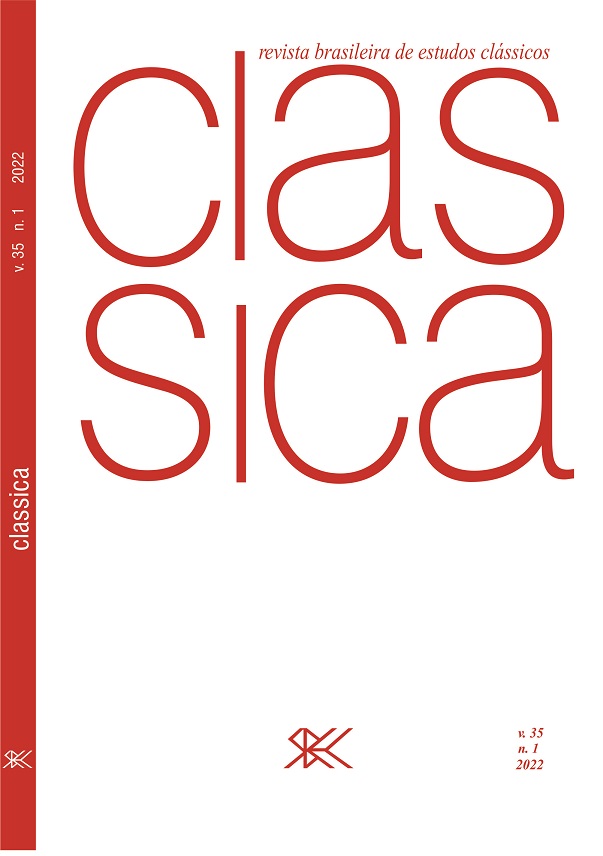O monumento de Antakya
A geografia política de Ḫamat e Arpad/Bīt-Agūsi no norte do levante entre os anos 806/805 e 796 A.E.C.
DOI:
https://doi.org/10.24277/classica.v35i1.974Palavras-chave:
Guerra no mundo antigo; estela de Antakya; Hamat; Bit-Agusi; Assíria.Resumo
O conflito circunstancial entre os reinos de Hamat e Arpad/Bit-Agusi se transformou em um problema regional porque ocorreu em rotas de acesso para o sul do Levante, região de territórios independentes sobre a qual a Assíria visava implementar seu sistema provincial. Por isso, a solução para o conflito diz respeito à estrutura imperial criada pela Assíria no antigo Oriente-Próximo. O monumento é representado como um agente social ou índice aramita que funda um novo programa político diante dos assédios do império neoassírio. Esta pesquisa tem por objetivo expor o monumento de Antakya na geografia política do norte do Levante. Na exposição historiográfica do monumento, será destacada a geografia política da qual Hamat e Arpad/Bit-Agusi faziam parte, assim como as antigas integrações culturais no vale do Orontes, visando analisar o conflito causado pela demarcação das bordas.
Downloads
Referências
Fontes
DONBAZ, Veysel. Two Neo-Assyrian stelae in the Antakya and Kahramanmaraş Museums. ARRIM, Toronto, v. 8, S. 5-24, 1990.
YOUNGER, K. Lawson. Antakya stela (2.114A). In: HALLO, William W. (ed.). CoS. v. 2: Monumental Inscriptions from the Biblical World. Leiden: Brill, 2000, p. 272.
Bibliografia
BAGG, Ariel M. At the limits of historical geography. Leiden: Brill, 2019.
BRYCE, Trevor. The world of the neo-hittite kingdoms: a political and military history. Oxford. Oxford University Press, 2012.
BUNNENS, Guy. Confrontation, emulation and ethno-genesis of the aramaeans in Iron Age Syria. In: OMER, Sergi; OEMING, Manfred; HULSTER, Izaak J. de (ed.). In search for Aram and Israel: politics, culture, and identity. (ORA 20). Tübingen: Mohr Siebeck, 2016, p. 253-80.
CASTEX, Anne-Renée. La moyenne vallée de l’Oronte à l’époque néo-assyrienne, regards croisés: les sources épigraphiques. Syria: Archéologie, Art et Histoire, Paris, v. IV, p. 207-13, 2016.
DUŠEK, Jan. The kingdom of Arpad/Bīt-Agūsi: its capital, and its borders. In: DUŠEK, Jan; MYNÁŘOVÁ, Jana (ed.). Aramaean borders: defining aramaean territories in the 10th-8th centuries B.C.E. (CHANE 101). Leiden: Brill, 2019, p. 172-202.
ELLIGER, Karl; RUDOLPH, Wilhelm (Hrsg.). Biblia Hebraica Stuttgartensia. 5. aufl. Stuttgart: Deutsche Bibelgesellschaft, 1997.
HAWKINS, John David. Hamath in the Iron Age: the inscriptions. Syria: Archéologie, Art et Histoire, Paris, v. IV, p. 183-90, 2016a.
HAWKINS, John David. Appendix: the find-spot of the Antakya stele. Syria: Archéologie, Art et Histoire, Paris, v. IV, p. 191-2, 2016b.
LIVERANI, Mario. Assyria: the imperial mission. Trad. Andrea Trameri and Jonathan Valk. (MC 21). University Park, PA: Eisenbrauns, Pennsylvania State University Press, 2017.
MAZZONI, Stefania. The aramean states during the Iron Age II-III periods. In: STEINER, Margreet L.; KILLEBREW, Ann E. (ed.). The Oxford handbook of the archaeology of the Levant: c. 8000-332 BCE. Oxford: Oxford University Press, 2014, p. 683-705.
MIEROOP, Marc van de. Historia del PróximoOrienteantiguo: ca. 3000-323 A.E.C. Trad. Sara Arroyo y Andrés Piquer. (BCBO). Madrid: Trotta, 2020.
NOEGEL, Scott B. The Zakkur Inscription. In: CHAVALAS, Mark W. (ed.). The ancient Near East: historical sources in translation. London: Blackwell, 2006, p. 307-11.
OSBORNE, James F. Sovereignty and territoriality in the city-state: a case study from the Amuq Valley. JAA, v. 32, p. 774-90, 2013.
PITARD, Wayne T. Old Aramaic inscriptions. The Melqart stela (2.33). In: HALLO, William W. (ed.). CoS. v. 2: Monumental inscriptions from the biblical world. Leiden: Brill, 2000, p. 152-3.
RICHELLE, Matthieu. The fluctuating borders of Hamath (10th-8th centuries B.C.E.). In: DUŠEK, Jan; MYNÁŘOVÁ, Jana (ed.). Aramaean borders: defining aramaean territories in the 10th-8th centuries B.C.E. (CHANE 101). Leiden: Brill, 2019, p. 203-28.
YOUNGER, K. Lawson. A political history of the arameans: from their origins to the end of their polities. (SBLABS 13). Atlanta, GA: SBL Press, 2016.
ZWICKEL, Wolfgang. Borders between Aram-Damascus and Israel: a historical investigation. In: DUŠEK, Jan; MYNÁŘOVÁ, Jana (ed.). Aramaean borders: defining aramaean territories in the 10th-8th centuries B.C.E. (CHANE 101). Leiden: Brill, 2019, p. 267-335.
Publicado
Edição
Seção
Licença
Copyright (c) 2022 João Batista Ribeiro Santos

Este trabalho está licenciado sob uma licença Creative Commons Attribution 4.0 International License.
Autores que publicam nesta revista concordam com os seguintes termos:
a. Autores mantém os direitos autorais e concedem à revista o direito de primeira publicação, com o trabalho simultaneamente licenciado sob a Creative Commons Atribuição 4.0 Internacional (CC BY 4.0) que permite o compartilhamento do trabalho com reconhecimento da autoria e publicação inicial nesta revista.
b. Autores têm autorização para assumir contratos adicionais separadamente, para distribuição não-exclusiva da versão do trabalho publicada nesta revista (ex.: publicar em repositório institucional ou como capítulo de livro), com reconhecimento de autoria e publicação inicial nesta revista.
c. Autores têm permissão e são estimulados a publicar e distribuir seu trabalho online após o processo editorial (ex.: em repositórios institucionais ou na sua página pessoal), já que isso pode gerar alterações produtivas, bem como aumentar o impacto e a citação do trabalho publicado (Veja O Efeito do Acesso Livre).
d. Autores autorizam a cessão, após a publicação, de seu conteúdo para reprodução em indexadores de conteúdo, bibliotecas virtuais, bases de dados de acesso público e similares.











